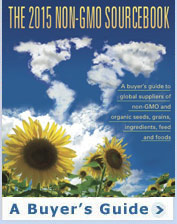Scientist finding many negative impacts of Roundup Ready GM crops
USDA doesn’t want to publicize studies showing negative impacts
Robert Kremer is a microbiologist with the US Department of Agriculture’s Agricultural Research Service and an adjunct professor in the Division of Plant Sciences at the University of Missouri. He is co-author of one of five papers published in the October 2009 issue of The European Journal of Agronomy that found negative impacts of Roundup herbicide, which is used extensively with Roundup Ready genetically modified crops. Kremer has been studying the impacts of glyphosate, the primary ingredient in Monsanto’s Roundup herbicide, since 1997.
The Organic & Non-GMO Report interviewed Mr. Kremer about his research and the reluctance of the USDA to publicize the findings of the five papers.
Please give me an overview of your research
RK: We started in 1997 wanting to see if this new system, Roundup Ready, would change the production of nematodes in soybean. We started looking at organisms in soybean roots and saw microorganisms colonizing the roots. We suspected that glyphosate was having an impact. There was a root fungi problem that seemed to be encouraging sudden death syndrome (SDS).
We saw the increase of these fungi in the Roundup Ready (genetically modified) system, both soybeans and corn.
What types of things are you seeing in the Roundup Ready system?
RK: This system is altering the whole soil biology. We are seeing differences in bacteria in plant roots and changes in nutrient availability. Glyphosate is very systemic in the plant and is being released through the roots into the soil. Many studies show that glyphosate can have toxic effects on microorganisms and can stimulate them to germinate spores and colonize root systems. Other researchers are showing that glyphosate can immobilize manganese, an essential plant micronutrient.
What are glyphosate’s impacts on beneficial soil bacteria?
RK: The most obvious impact is on rhizobia, a bacterium that fixes nitrogen. It has been shown that glyphosate can be toxic to rhizobia. (Nitrogen fixing bacteria are important to soils because nitrogen is the most commonly deficient nutrient in many soils.)
What about research showing increased incidence of Fusarium in Roundup Ready GM crops?
RK: We’ve taken field surveys and seen an increase in Fusarium with the use of glyphosate. Some Roundup Ready varieties even without using glyphosate tend to be more susceptible to being impacted by Fusarium. It could be an unintended consequence of genetic manipulation that could make it more susceptible.
Your paper also mentioned the potential of glyphosate to contaminate groundwater.
RK: Yes, under certain circumstances. The big assumption for claims that glyphosate is benign is that it isn’t immediately absorbed by the soil. But research is showing that isn’t necessarily true; that it is still available in the soil.
If soil is full of phosphorous, glyphosate could leach into ground water. For example, farmers may use manure from confined animal feeding operations as a fertilizer. The soil will then contain high amounts of phosphorus, which overwhelms the soil. Any glyphosate that hits the soil will be a potential contaminant. It can stay in the soil or it might run off into streams or waterways.
What about glyphosate resistant weeds?
RK: We have eight different species of glyphosate resistant weeds in Missouri. Some species of Johnson Grass are found in fields where Roundup is used year after year. It is a very aggressive weed.
To solve the problem of weed resistance, genetic engineers are developing soybeans that tolerate Roundup and Dicamba, another herbicide. They are incorporating another gene resistant to another herbicide. When resistance happens again, will they then develop a plant resistant to five or six herbicides? It’s an illogical circle.
With so much glyphosate being used, what types of long-term impacts do you think could occur?
RK: We are already seeing glyphosate-resistant weeds. If we continue to use glyphosate in the same fields year after year, it’s a matter of time until microbial communities in the soil will shift to more detrimental species.
The use of glyphosate stimulates detrimental pathogens in the growing season but they go back down after the growing season. Eventually, they may build up in the soil and not go back down.
Are many researchers looking at the possibly negative impacts of glyphosate or Roundup Ready crops?
RK: There are a handful of researchers. There is more research looking at the production of these crops.
The papers published in the European Journal of Agronomy received no publicity in the United States. Why is that?
RK: I was working with USDA-ARS to publish a news release about these studies. I’ve gone all the way to the administrators, but they are reluctant to put something out. Their thinking is that if farmers are using this (Roundup Ready) technology, USDA doesn’t want negative information being released about it. This is how it is. I think the news release is still sitting on someone’s desk.
What about your future research?
RK: We’re looking at some methods that could be used to overcome negative effects if we continue to use Roundup Ready crops, such as supplementation of nutrients by foliar application.
I’m more interested in sustainable agriculture. More farmers are interested in using cover cropping to maintain soil quality and other organic amendments. But it’s a steep learning curve for them.
© Copyright January/December 2010 , The Organic & Non-GMO Report




